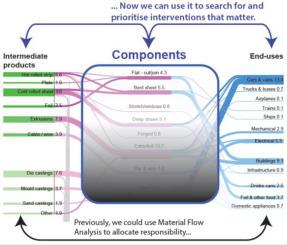将环境系统分析与制造技术相结合:世界钢铁和铝部件目录
IF 11.2
1区 环境科学与生态学
Q1 ENGINEERING, ENVIRONMENTAL
引用次数: 0
摘要
为了减少温室气体排放,环境系统界开发了物质流分析来描述资源向产品的转化,而制造技术界则开发了能够影响单个组件生产的创新技术。然而,这两个群体一直处于脱节状态,因为他们都无法将自己的见解与共同关心的问题联系起来:零部件的全球生产。本文首次将钢和铝的全球使用分析与按金属成型工艺分类的零部件生产联系起来。分析结果表明,在全球范围内,钢和铝在十个不同的部件组中的使用比例,以及推动这两种金属需求的主要产品组的使用比例。这既有助于确定设计和制造创新要求的优先次序,也有助于评估此类创新的排放潜力。本文章由计算机程序翻译,如有差异,请以英文原文为准。

Connecting environmental systems analysis to manufacturing technology: A catalogue of the world's steel and aluminium components
In pursuit of greenhouse gas emissions reductions, the environmental systems community has developed material flow analyses to describe the transformation of resources into goods, while the manufacturing technology community has developed innovations that can affect the production of individual components. However, these two communities have remained disconnected, because neither is able to relate their insights to their point of common interest: the global production of components. For the first time, this paper connects global analyses of the use of steel and aluminium to the production of components, classified by the metal forming processes which shape them. The results demonstrate the proportions of steel and aluminium used in ten distinct component groups, at global level, and for the major product groups which drive demand for these two metals. This helps both to prioritise requirements for innovation in design and manufacturing and to evaluate of the emissions potential of such innovations.
求助全文
通过发布文献求助,成功后即可免费获取论文全文。
去求助
来源期刊

Resources Conservation and Recycling
环境科学-工程:环境
CiteScore
22.90
自引率
6.10%
发文量
625
审稿时长
23 days
期刊介绍:
The journal Resources, Conservation & Recycling welcomes contributions from research, which consider sustainable management and conservation of resources. The journal prioritizes understanding the transformation processes crucial for transitioning toward more sustainable production and consumption systems. It highlights technological, economic, institutional, and policy aspects related to specific resource management practices such as conservation, recycling, and resource substitution, as well as broader strategies like improving resource productivity and restructuring production and consumption patterns.
Contributions may address regional, national, or international scales and can range from individual resources or technologies to entire sectors or systems. Authors are encouraged to explore scientific and methodological issues alongside practical, environmental, and economic implications. However, manuscripts focusing solely on laboratory experiments without discussing their broader implications will not be considered for publication in the journal.
 求助内容:
求助内容: 应助结果提醒方式:
应助结果提醒方式:


